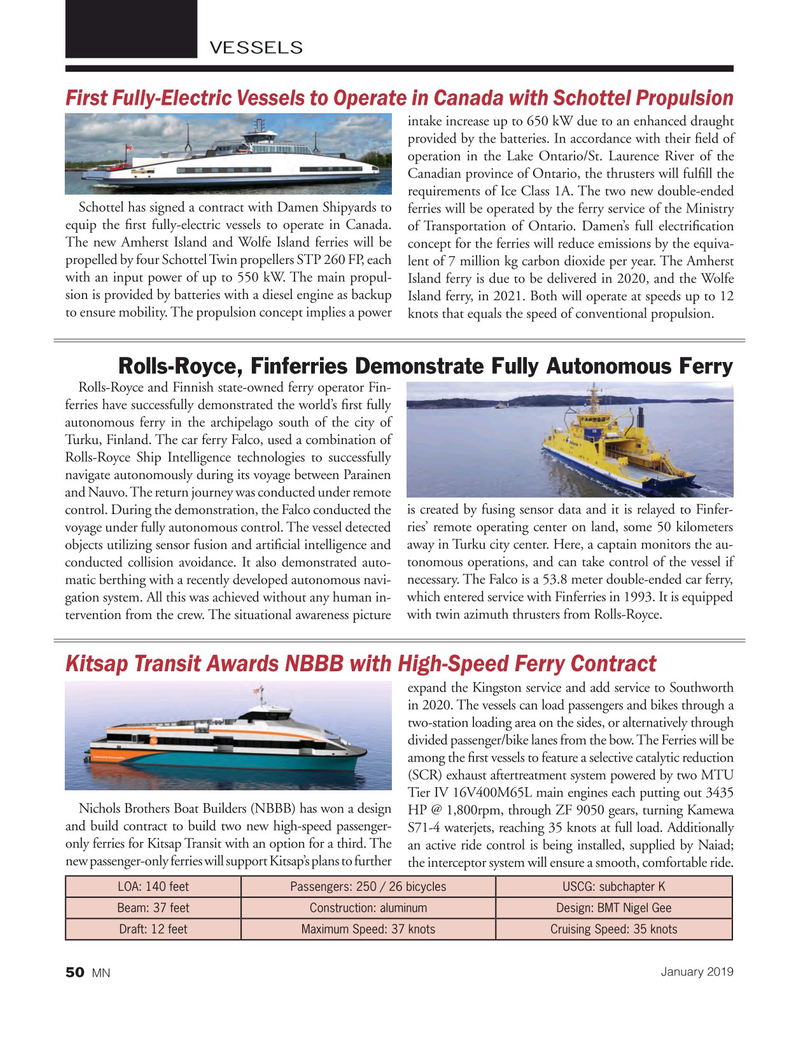
Page 50: of Marine News Magazine (January 2019)
Passenger Vessels & Ferries
Read this page in Pdf, Flash or Html5 edition of January 2019 Marine News Magazine
VESSELS
First Fully-Electric Vessels to Operate in Canada with Schottel Propulsion intake increase up to 650 kW due to an enhanced draught provided by the batteries. In accordance with their ? eld of operation in the Lake Ontario/St. Laurence River of the
Canadian province of Ontario, the thrusters will ful? ll the requirements of Ice Class 1A. The two new double-ended
Schottel has signed a contract with Damen Shipyards to ferries will be operated by the ferry service of the Ministry equip the ? rst fully-electric vessels to operate in Canada. of Transportation of Ontario. Damen’s full electri? cation
The new Amherst Island and Wolfe Island ferries will be concept for the ferries will reduce emissions by the equiva- propelled by four Schottel Twin propellers STP 260 FP, each lent of 7 million kg carbon dioxide per year. The Amherst with an input power of up to 550 kW. The main propul- Island ferry is due to be delivered in 2020, and the Wolfe sion is provided by batteries with a diesel engine as backup Island ferry, in 2021. Both will operate at speeds up to 12 to ensure mobility. The propulsion concept implies a power knots that equals the speed of conventional propulsion.
Rolls-Royce, Finferries Demonstrate Fully Autonomous Ferry
Rolls-Royce and Finnish state-owned ferry operator Fin- ferries have successfully demonstrated the world’s ? rst fully autonomous ferry in the archipelago south of the city of
Turku, Finland. The car ferry Falco, used a combination of
Rolls-Royce Ship Intelligence technologies to successfully navigate autonomously during its voyage between Parainen and Nauvo. The return journey was conducted under remote control. During the demonstration, the Falco conducted the is created by fusing sensor data and it is relayed to Finfer- voyage under fully autonomous control. The vessel detected ries’ remote operating center on land, some 50 kilometers objects utilizing sensor fusion and arti? cial intelligence and away in Turku city center. Here, a captain monitors the au- conducted collision avoidance. It also demonstrated auto- tonomous operations, and can take control of the vessel if matic berthing with a recently developed autonomous navi- necessary. The Falco is a 53.8 meter double-ended car ferry, gation system. All this was achieved without any human in- which entered service with Finferries in 1993. It is equipped tervention from the crew. The situational awareness picture with twin azimuth thrusters from Rolls-Royce.
Kitsap Transit Awards NBBB with High-Speed Ferry Contract expand the Kingston service and add service to Southworth in 2020. The vessels can load passengers and bikes through a two-station loading area on the sides, or alternatively through divided passenger/bike lanes from the bow. The Ferries will be among the ? rst vessels to feature a selective catalytic reduction (SCR) exhaust aftertreatment system powered by two MTU
Tier IV 16V400M65L main engines each putting out 3435
Nichols Brothers Boat Builders (NBBB) has won a design HP @ 1,800rpm, through ZF 9050 gears, turning Kamewa and build contract to build two new high-speed passenger-
S71-4 waterjets, reaching 35 knots at full load. Additionally only ferries for Kitsap Transit with an option for a third. The an active ride control is being installed, supplied by Naiad; new passenger-only ferries will support Kitsap’s plans to further the interceptor system will ensure a smooth, comfortable ride.
LOA: 140 feet Passengers: 250 / 26 bicycles USCG: subchapter K
Beam: 37 feet Construction: aluminum Design: BMT Nigel Gee
Draft: 12 feet Maximum Speed: 37 knots Cruising Speed: 35 knots
January 2019 50
MN
MN Jan19 Layout 50-59.indd 50 MN Jan19 Layout 50-59.indd 50 1/9/2019 9:27:27 AM1/9/2019 9:27:27 AM

 49
49

 51
51
